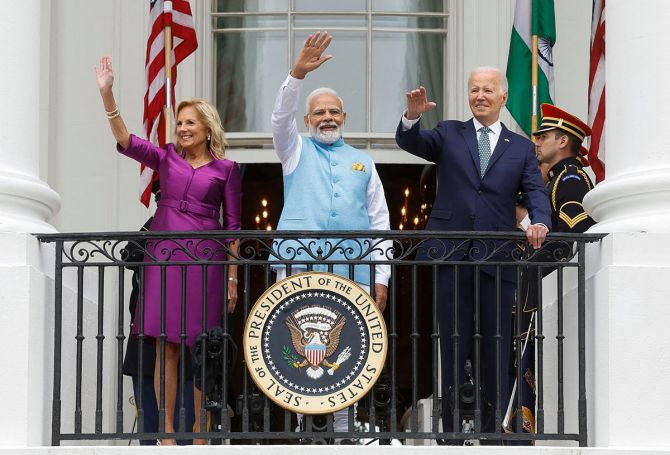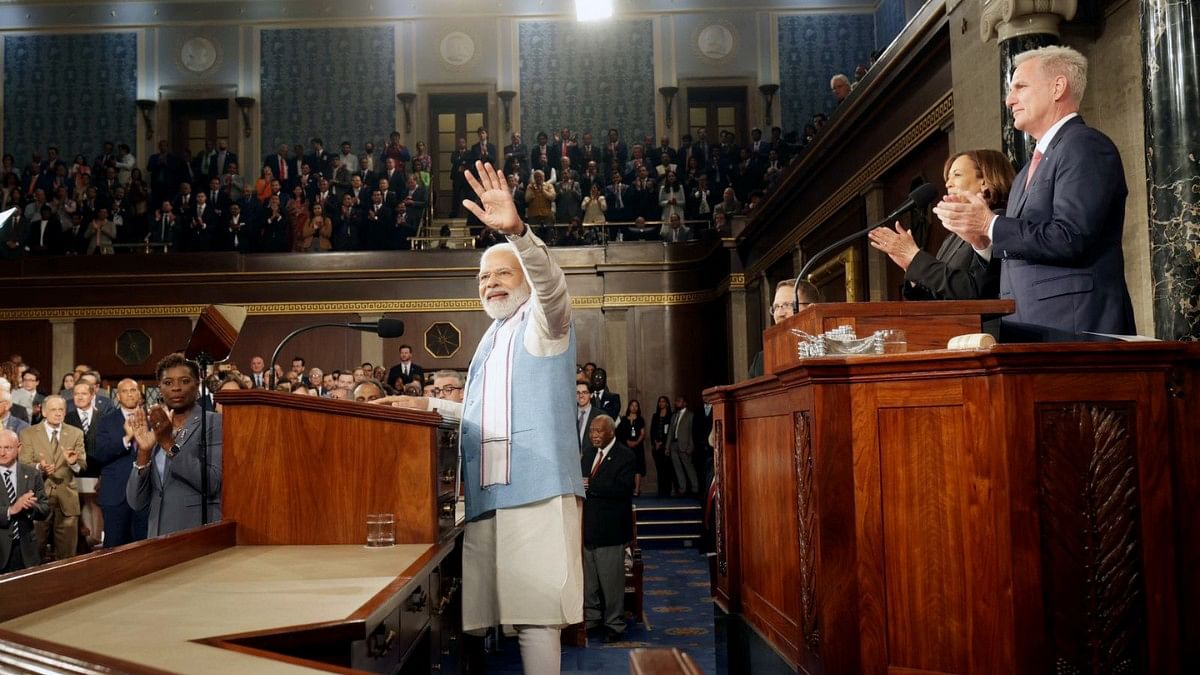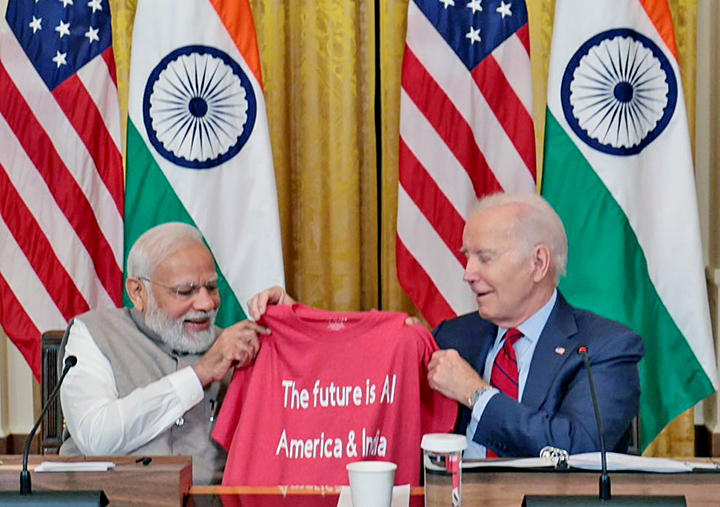
Prime Minister Narendra Modi recently concluded his maiden state visit to the United States. From defence cooperation to space collaboration, several important areas remained the talking points of this visit. How significant the visit was, can be understood by the fact that it was only the third ‘state visit’ hosted by President Joe Biden after assuming office (French PM Emmanuel Macron and South Korean Prez Yoon Suk Yeol others). In this Blog, we will understand its takeaways, the brewing closeness between India and US as “comprehensive strategic partners” and also a look at the ‘concerns’ raised about Democracy in India.
Meaning and Timing of ‘State Visit’
Although PM Modi had travelled to the US, 7 times as Prime Minister, this was the first ‘state visit’. A state visit holds a special significance as compared to other foreign visits, as this is a formal visit by the head of state to a foreign country at the invitation of the head of state hosting him. In this case, it was Biden who had invited Modi. A state visit signifies the highest expression of friendly bilateral ties between two sovereign nations. Also, during a State visit, the leader extending the invitation acts as the official host of the visiting head of state throughout the trip. It was personally a big moment for me too, as I got to cover such a huge visit from the newsroom.
This visit came at a time when India is at the helm of being a rising force at the world level; both as a rising economic power as well as a possible ‘counter-balance’ to Beijing in the Indo-Pacific region. During the visit, PM Modi led a special yoga session at the UN headquarters. He also held bilateral talks with President Biden and had some ‘samosa’ (yum) and ‘khichdi’ (eww) at the White House. Also, PM Modi became only the second world leader to address US Congress twice; the only other being Israeli PM Benjamin Netanyahu (what a consistency in ideology). His address, honestly was BRILLIANT, touching on geopolitical concerns, India-US ties, Cricket World Cup, Halloween-Naatu Naatu, to even the ‘Samosa Caucus’ remark.

PM Modi with President Joe Biden and First Lady Jill Biden at the White House (Photo: Rediff.com)
Major Takeaways of the Visit
Defence Cooperation: Collaboration between the two countries in the field of defence was one of the main upshots of the visit. India’s Hindustan Aeronautics Limited (HAL) and General Electric will jointly produce GE-F414 fighter jet engines that will power India’s indigenous Light Combat Aircraft (LCA) Tejas Mk-II. In another major deal, Indian defence forces will also procure 31 MQ-9B High Altitude Long Endurance (HALE) drones from the US, strengthening India’s surveillance and attack capabilities.
Technological Cooperation: In a mega far-sighted deal, Micron Technology will invest up to USD 825 million (in addition to what the Indian government invests) to build a new semiconductor assembly and test facility in India. This is big especially, after the discovery of lithium reserves in India. The two countries will also collaborate on advanced telecommunications, including Open RAN and 5G/6G research and development. Recently, India and US also came together on iCET (Initiative on Critical and Emerging Technologies), which is very significant for India, because ‘critical technology’ has been an area, where India has lagged behind other strong defence countries.
Artemis Accord: A significant development of the tour was India signing the Artemis Accord with the US, which is a space collaboration to send humans to the moon and carry out expand space exploration to Mars and beyond. Under this, many ISRO scientists will train at teh International Space Station (ISS), share world-class technologies and subsequently the ISRO-NASA will launch a joint mission that is expected to take off in 2024.
Trade disputes: Despite all the Indo-US ‘friendship’ being talked about, it is pertinent that there are several trade disputes between both countries. On a positive note, both countries decided to end as many as 6 disputes at the World Trade Organisation (WTO), while one dispute is still ongoing, which the two countries ‘intend’ to resolve soon.
People-to-people ties: Well…this was a word mentioned no less than 100 times by both the leaders and other officials during the state visit. It is no surprise that the 4 million Indian diaspora in the US has guided the India-US ties lately. As a result, the US has decided to open its consulates in Ahmedabad and Bengaluru, while India too will open its mission in Seattle.

PM Modi addressed the joint session of US Congress for the second time (Photo: The Print)
The Closeness of the US and India
Now, there are several reasons for the growing India-US relations. First, as almost everyone points out, China’s rise as an ‘Expansionist Superpower’ has compelled the West (led by the US) to develop cordial relations with India. There are several dimensions to it, with such a volatile leader at the helm in China, makes it important that there is another strong supply chain in the region. India’s location is a potent factor too, as China’s expansionist tendency in the Indo-Pacific region has further brought India and US closer in the defence arena. And this urge is not one-sided. India too needs a power like the US to help develop its industrial and defence capabilities to fare better globally — at a time when India is looking to diversify its defence source after the Russia-Ukraine conflict. Also, whatever scepticism India had were brushed aside after repeated Chinese aggression on the borders. Collaborations like Quad and I2U2 are further proof of the growing ties between the two.
However, one misconception should be cleared, ‘China’ is not the only reason for the propelling of India-US relations. A major factor here is the huge (both in quantity and quality) amount of Indian Americans living in the US. Their participation has risen not just in workforce and social groups, but also politically. So, it is very obvious that America would like to have cordial ties with its origin country. Also, India itself happens to have a strong developing economy. Being the fastest growing economy currently, India is poised to become the third largest economy in the world a little after 2030 (irrespective of which party remains in power). Again, it is only wise to be on the ‘right’ side of the spectrum.

What all PM Modi had during his all-vegetarian state dinner at the White House (Photo: Business Today)
Tracking India-US relations over the years
Now, another misconception, people have is that cordial India-US relations are the “sole making” of the Modi government. We have to also understand the timeline of India-US relations for understanding it better. Post-independence, India was a severely backward country, so a country like the US didn’t have much ‘interest’ here. Despite that, former PM Jawaharlal Nehru received warm receptions during his eight visits to America. However, after the demise of both Nehru and Roosevelt (former US President), the ties took a hit. There was a time, when the US didn’t consider India worthy enough, even for providing wheat during the food crisis of the 1960s.
Former US Prez Nixon went on to call Indira Gandhi a “bitch”, showing what stature India had in the US eyes. On the very contrary, ‘Pakistan’ used to be a very close ally of the US. The reason was that Washington’s interests lay in the Afghanistan region, which was under the Soviets at that time. So, for bolstering the rise of the Taliban (Yes…you heard it right) and the fall of the Soviets, the US needed Pakistan. For the very extreme, during the 1971 Indo-Pak war — which led to the creation of Bangladesh — the US even sent its Naval forces for Pakistan’s aid against India. It was only after the Soviets sent theirs that the US halted its operations.
Another extreme was when the US sanctioned India for conducting nuclear tests, at a time when it possessed a much higher amount of nuclear potential. Now, this can very well be considered as the inflexion point of India-US relations. Because, post this India-US relations only improved. A big reason was that the US now started reducing its focus from Afghanistan, so it no longer needed Pakistan as an ally. Another factor was India’s rise as an economic power, which the US couldn’t have ignored.
As a matter of fact, these cordial relations developed across party lines. From Bharat Ratna awardee Atal Bihari Vajpayee to former PM Manmohan Singh, both contributed heavily to this. One of the biggest achievements of the latter’s tenure was signing the nuclear deal with the same US which had sanctioned it earlier. Singh was also the second Indian leader to go on a US state visit (former President Sarvapalli Radhakrishnan being the first). So, if you look closely, since around the year 2000 only, India-US relations have been on the rise. Joe Biden (Vice President then) had even expressed strong advocacy for India-US ties. So, today it should not be a big surprise if he is extending his arms on the same front, irrespective of the fact that he is the same leader who criticised the abrogation of Article 370 and the implementation of the Citizenship Amendment Act (CAA) by the Modi government.

Former President Barack Obama stressed an important point (Photo: Hindustan Times)
The Obama remark and ‘Democracy’ concerns
Now, whatever I have presented above, I have tried to refrain from putting in my opinion as much as possible and presented solely facts. But, this section needs to be opinionated, as it is about an ‘opinion’ after all. Former US President Barack Obama during an interview with CNN, stated that “protection of the Muslim minority in a Hindu-majority India” is an issue worth being raised during Biden’s talks with Modi. Obama further added that he would have told Modi — with whom he had nice relations while in office — that “if you do not protect the rights of ethnic minorities in India, then there is a strong possibility that India at some point starts pulling apart”.
But, there are some things that should be pointed out. Democrat party in the US is known for its liberal and left-to-centre stand, so Biden’s warm reception of Modi and silence on human rights issues can hurt their ‘vote bank’. So, for the Democrats, their tallest leader speaking on the issue very much looks like damage control. Also, a country that fostered the Taliban, supported many dictators and is known for selective stands can’t lecture India. But, I personally like to take every statement by its merit. And, in a healthy discussion, it is very important that we listen to every opinion Here it is from perhaps one of the most popular world leaders of all time. So…if you go by my opinion, I very much agree with what Mr Obama opines. And, there is no rocket science that if one community is being discriminated against and persecuted, it will be detrimental to the interests of that country.
These remarks were supposed to have irked the ruling BJP…and it did. Firstly, Assam CM Himanta Biswa Sarma, in an extremely “threatening and hateful” tweet stated that there are many “Hussain Obama” in the country who need to be “taken care of”. Well, isn’t he just going on to prove what Obama was pointing out? After all, such statements are often ‘rewarded’ in the party, as we have also seen in the case of “Goli Maaro” infamy. The other defence BJP has brought is that Obama, under his tenure bombed six Muslim nations. Well, the allegation is true as these attacks —although targeted terrorists— also killed many civilians. However, the two cases are not actually comparable. Are we implying, that since Obama carried out attacks on Yemen, Syria and others, we should be ‘okay’ with any religious attack in the country?
The other human-right debate erupted when Wall Street Journal journalist Sabrina Siddiqui asked PM Modi, about the “crackdown on minorities” in India and the “steps he would take to resolve it”. He, trying to play it safe, gave quite a generic answer, that “India is a democracy by heart and soul, and there is no question of discrimination based on caste, gender or religion,” and literally brushed off all the hate speeches, mob lynchings and polarisation that has happened under his tenure. I would like to point out two things here. Firstly, this showed why after all Modi, NEVER faces the media. Secondly, everyone should know that Modi and the Indian delegation were persisting in “not taking” this press conference too and it was only after the US stressed —as it had invested so much in the visit—that he had to. On expected lines, the IT cell and trolls targeted Siddiqui for asking the ‘right’ question, after which the White House had to issue a condemnation. The episode did represented India in bad light.

President Biden gifted PM Modi a T-Shirt with his own quote (Photo: The Sunday Guardian Live)
The Future is AI
“Today marks a new chapter in the India-US relations…only the sky is the limit…the future is AI: America and India”
These were the words of our Prime Minister signifying the direction of where India-US relations are headed. But, as many experts have pointed out, India will NEVER be that puppet ally, if the US is even thinking that. Indian foreign policy is marked by strategic autonomy and will continue like that…especially under the Modi government. Yes, India is diversifying its defence purchases, but it is also buying oil from Russia unapologetically. It is collaborating with the US on I2U2 and Quad, but will never sanction or be the first attacker towards China or Russia.
Also, as I had pointed out before too, India’s stature at the global level is way too important for the West currently, that it will continue to brush off all ‘human rights’ concerns. After all, if you look at the history of the US, it shouldn’t be a surprising thing for you. Yes, the issues might be raised, just like this time. The 75 US lawmakers may continue to write to the President, and the US Religious Freedom Panel may continue to ask for blacklisting India; but on a broader level, irrespective of which party is in power —both in India and the US—the ties between the two countries will continue to blossom. Now, whether you like it or not, that’s the truth.

